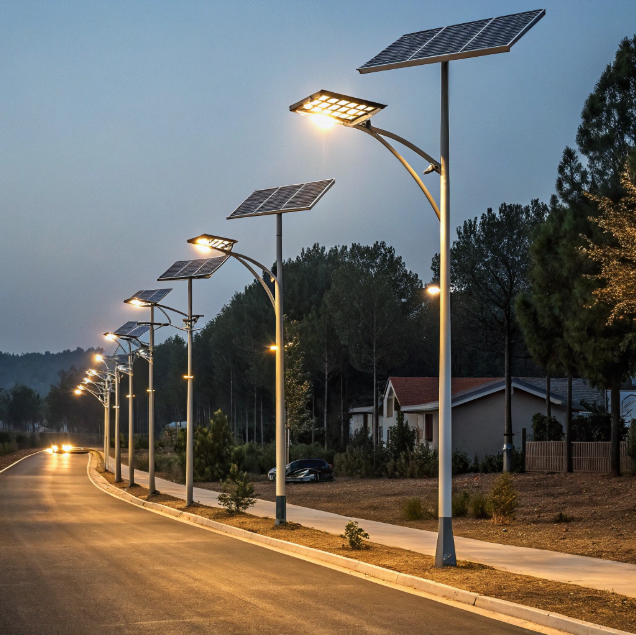How One Dark Street Can Ruin a City's Reputation, and Why Solar Lighting is the Fastest Fix?
by
How One Dark Street Can Ruin a City's Reputation, and Why Solar Lighting is the Fastest Fix?
Picture this: one poorly lit street becomes the talk of the town—for all the wrong reasons. Crime spikes, businesses suffer, and residents feel unsafe. The problem? Traditional street lighting fails when it's needed most.
Dark streets damage city reputations by increasing crime rates and reducing public safety perception. Solar lighting offers immediate installation without trenching, providing reliable illumination that enhances security and community trust rapidly.
But why does one dark street have such an outsized impact on community perception? And how can cities address this issue without massive infrastructure investments? Let's explore why solar lighting[^1] isn't just an alternative—it's the smartest solution for modern urban challenges.
The Hidden Cost of Grid-Tied Street Lights: Why Trenching & Cabling Make Solar the Cheaper Option From Day 1?
Municipal budgets are tight, yet cities keep pouring money into expensive grid connections. The hidden expenses might surprise you—and drain your resources.
Grid-tied lighting requires costly trenching, cabling, and utility connections that often exceed initial estimates. Solar lighting eliminates these expenses entirely, delivering immediate cost savings from installation day forward.
When cities opt for traditional grid-tied lighting[^2], they're committing to a cascade of hidden costs that solar solutions completely avoid. Let's break down the financial reality:
The True Cost Breakdown
| Expense Category | Grid-Tied Lighting | Solar Lighting |
|---|---|---|
| Trenching & Excavation | $50-$150 per linear foot | $0 |
| Underground Conduit & Cabling | $20-$40 per foot | $0 |
| Utility Connection Fees | $2,000-$5,000 per pole | $0 |
| Monthly Electricity Bills | $15-$30 per fixture | $0 |
| Maintenance Complexity | High (underground repairs) | Low (modular components) |
The installation process itself reveals why solar wins financially. Traditional lighting requires coordinating multiple contractors—excavation crews, electricians, utility workers—each adding layers of cost and potential delays. Solar installation? One crew, one day, no utility coordination needed.
Critical Insight: Most cities underestimate grid-tied costs by 40-60% because they fail to account for:
- Permitting delays for street closures
- Unexpected underground utility conflicts
- Long-term maintenance of buried infrastructure
The financial advantage becomes even clearer when considering future expansions or relocations. Grid-tied lights become permanent fixtures due to the sunk infrastructure costs, while solar lights can be relocated as community needs change—no additional infrastructure investment required.
3 Days of Rain, Still Shining: Deconstructing the 'Brain' of Our All-in-One Light (Battery + Controller) for Extreme Weather?
Stormy weather shouldn't mean dark streets. Yet traditional lights often fail when communities need them most. What makes solar lights so resilient?
Advanced battery management systems[^3] and weather-sealed controllers ensure solar lights operate continuously through extended bad weather, maintaining illumination when grid power often fails.
The secret to solar lighting's weather resilience lies in its intelligent control system—the "brain" that manages power through the toughest conditions.
Weather Resilience Components
| Component | Function | Extreme Weather Protection |
|---|---|---|
| Lithium Iron Phosphate Battery | Energy storage | Thermal management prevents performance degradation in temperature extremes |
| Smart Charge Controller | Power management | IP67 waterproof rating and surge protection |
| Battery Management System (BMS) | Safety monitoring | Prevents overcharging/discharging in low-light periods |
| Maximum Power Point Tracking | Efficiency optimization | Maintains charging efficiency even with partial shading |
The controller's intelligence goes beyond simple on/off functionality. During three consecutive rainy days, the system:
- Automatically conserves power by reducing brightness during low-traffic hours
- Prioritizes critical functions to ensure minimum 5-night autonomy
- Self-diagnoses issues and can even alert maintenance crews proactively
Real-World Performance: In coastal communities facing salt spray and high humidity, our solar lights maintain 95%+ uptime while traditional fixtures suffer corrosion and electrical failures. The sealed, integrated design means no exposed wiring or vulnerable connection points that weather can compromise.
Why Dim a Street Light to 30%? The Genius of Motion-Sensing & Timed Controls in Maximizing Battery Life?
Bright lights all night waste energy and money. Smart dimming technology ensures illumination when needed while dramatically extending system lifespan.
Motion-sensing and timed dimming reduce energy consumption[^4] by 60-70%, allowing solar lights to operate through extended low-sunlight periods without compromising safety.
The strategic dimming of solar street lights isn't about cutting corners—it's about intelligent resource management that benefits both municipalities and residents.
Smart Control Strategies
| Control Method | Energy Savings | Safety Impact |
|---|---|---|
| Motion-Activated Brightening | 40-50% | Immediate response to pedestrian/vehicle movement |
| Time-Based Dimming Schedules | 20-30% | Maintains baseline safety lighting |
| Adaptive Learning | 10-15% additional | Pattern-based optimization |
The system operates on a simple but effective principle: right light, right time. From 10 PM to 5 AM, when traffic is minimal, lights operate at 30% brightness. When motion sensors detect activity, they instantly brighten to 100% for 2-5 minutes before returning to conservation mode.
Battery Life Impact:
- Continuous 100% brightness: 2-3 year battery lifespan
- With smart dimming: 5-7 year battery lifespan
This approach creates a win-win: residents enjoy well-lit streets when moving about, while municipalities benefit from reduced maintenance costs and longer system lifetimes. The technology even learns traffic patterns, adjusting dimming schedules based on actual usage data rather than fixed timetables.
Conclusion
Solar street lighting transforms urban safety instantly, cutting costs while providing reliable illumination that enhances community reputation and resident security.
[^1]: Explore how solar lighting can enhance urban safety and reduce costs for cities.
[^2]: Discover why many cities are moving away from traditional grid-tied solutions.
[^3]: Find out how advanced technology enhances the reliability of solar lights.
[^4]: Explore strategies that municipalities can adopt for sustainable energy use.
Popular Posts
You may also be interested in:




